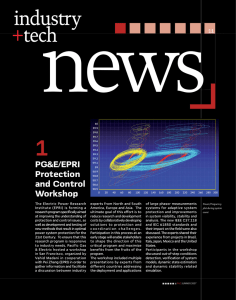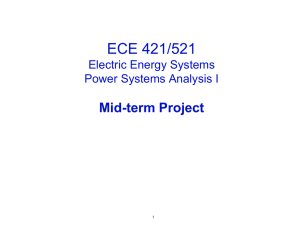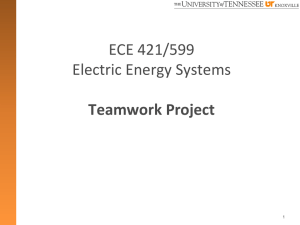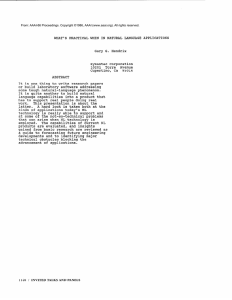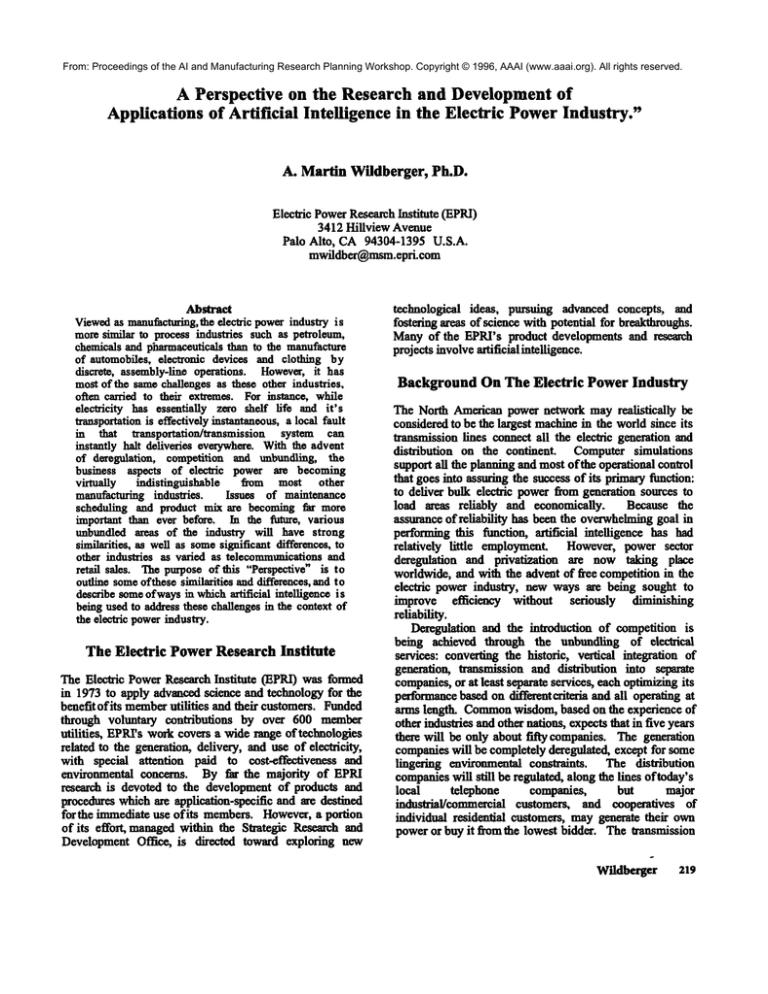
From: Proceedings of the AI and Manufacturing Research Planning Workshop. Copyright © 1996, AAAI (www.aaai.org). All rights reserved.
A Perspective on the Research and Development of
Applications of Artificial Intelligence in the Electric PowerIndustry."
A. Martin Wildberger,
Ph.D.
Electric PowerResearch Institute (EPRI)
3412 Hillview Avenue
Palo Alto, CA94304-1395 U.S.A.
mwildber~msm.epri.com
Abstract
Viewedas manufacturing,the electric powerindustry is
moresimilar to process industries such as petroleum,
chemicals and pharmaceuticalsthan to the manufacture
of automobiles, electronic devices and clothing by
discrete, assembly-fine operations. However,it has
mostof the samechallenges as these other industries,
often carried to their extremes. For instanze, while
electricity has essentially zero shelf llfe and it’s
transportation is effectively instantaneous,a local fault
in that transportation/transmission
system can
instantly halt deliveries everywhere.Withthe advent
of deregulation, competition ~d unbundling, the
business aspects of electric power are becoming
virtually
indistinguishable
from most other
manufacturing industries.
Issues of maintenance
scheduling and product mix are becoming far more
important than ever before. In the future, various
unbundled areas of the industry will have strong
similarities, as well as somesignificant differe~es, to
other industries as varied as telecommunicationsand
retail sales. The purpose of this "Perspective" is to
outline someofthese similarities and differences, and to
describesomeof waysin whichartificial intelligence i s
being used to address these challengesin the context of
the electric powerindustry.
The Electric
Power Research Institute
The Electric Power Research Institute (EPRI) was formed
in 1973 to apply advanced science and technology for the
benefit of its memberutilities and their customers. Funded
through voluntary contributions by over 600 member
utilities, EPRI’swork covers a wide range of technologies
related to the generation, delivery, and use of electricity,
with special attention paid to cost-effectiveness and
environmental concerns. By far the majority of EPRI
research is devoted to the development of products and
procedures which are application-specific and me destined
forthe immediate use ofits members. However, a portion
of its effort, managedwithin the Strategic Research and
Development Office, is directed toward exploring new
technological ideas, pursuing advanced concepts, and
fostering areas of science with potential for breakthroughs.
Manyof the EPRI’s product developments and research
projects involveartificial intelligence.
Background On The Electric
Power Industry
The North American power network may realistically
be
considered to be the largest machinein the world since its
transmission lines connect all the electric generation and
distribution on the continent. Computer simulations
support all the planning and most of the operational control
that goes into assuring the success of its primary function:
to deliver bulk electric powerfrom generation sources to
load areas reliably and economically. Because the
assurance of reliability has been the overwhelminggoal in
performing this function, artificial intelligence has had
relatively little employment. However, power sector
deregulation and privatization are now taking place
worldwide, and with the advent of free competition in the
electric power industry, new ways me being sought to
improve efficiency without seriously diminishing
reliability.
Deregulation and the introduction of competition is
being achieved through the unbundling of electrical
services: converting the historic, vertical integration of
generation, transmission and distribution into separate
companies,or at least separate services, each optimizingits
performancebased on different criteria and all operating at
arms length. Common
wisdom, based on the experience of
other industries and other nations, expectsthat in five years
there will be only about fifty companies. The generation
companieswill be completely deregulated, except for some
lingering environmental constraints. The distribution
companieswill still be regulated, along the lines of today’s
local
telephone
companies,
but
major
industrial/commercial customers, and cooperatives of
individual residential customers, maygenerate their own
power or buy it from the lowest bidder. The transmission
Wildberger
219
companicswill bc partly regulated in an attempt to ensure
open access and non-discriminatory pricing for "’wheeling"
powerbetween any generator and any user or distributor,
while maintaining some level of system security despite
their lack of control of either generationor load.
Ona limited basis, several utilities are beginning to
employ remote control,
distributed
sensing, and
communications methods to improve network performance.
High-speed electronic power controllers such as FACTS
(flexible ACtransmission system) devices represent
especially promising technology. By replacing the slow
mechanical switches now used to manage system
operations, these controllers offer for the first time the
potential to dynamically fine-tune transmission so that
powerdelivery can respond instantly to changcs in demand
without the burden of maintaining large amounts of
"spinning reserve" generation. However, these devices
represent a two-edged sword. On the one hand, they me
capable of controlling the system’s inherent modal
behavior and directing the flow of active powerto whereit
is wanted by accepting changes in reactive power
elsewhere. But, on the other hand, increased use of highspeed electronic controllers like FACTSpresents more
opportunities for large disturbances to occur. In addition,
the use of economically beneficial, high voltage direct
current (HVDC) interconnectious
also encourages
dependence on geographically remote power sources,
makingthe new controls associated with them essential for
secure &stable operation.
It is ironic that, just as system-wide control and
information exchange is becoming possible through
technology, political considerations are preventing it from
taking place. However,this provides both an opportunity
and a challenge for the use of artificial intelligence to aid
each separately controlled part of the system in the
optimization of its ownprofitability by adapting rapidly to
changes in the other parts. Forecasting, producing
estimates based on limited information, and calculating the
cost/benefit of additional information will be essential to
success in a marketthat will include complex"derivatives"
based on future options to powerproduction, transmission
capacity and segmenteddelivery services.
The electric powerindustry is similar in manyways to
the telecommunicationsand transportation industries, but
it has important differenceswhich cannot bc ignored in its
practical operations, whether regulated or market driven,
integrated or unbuudled. While electricity also "flows"
(from high voltage to low voltage locations),
its
transmission is inherently different from that of gas or
water:
¯ Powerflows through the grid in inverse relation to the
impedanceon each line.
¯ Electric power systems use phase shiflers rather than
valves.
¯ Providing the required flow on one line often results in
"loop flows" on several other lines
¯ Despite batteries and capacitors, and in contrast to "line
packing"of gas or the use of reservoirs for water, there
is no©practical
way
to store largeAllamounts
of electricity
From: Proceedings of the AI and Manufacturing Research Planning Workshop. Copyright
1996, AAAI
(www.aaai.org).
rights reserved.
220
M & Manufacturing Workshop
forany significant length of time.
Reliable electric service is critically dependenton the
ability to respond to changedconditions
instantaneously.
¯ Global stability is cssential for local efficiency, but
every local changehas someeffecton global stability.
For an electric power network, there are three basic
operating requirements:
¯ all componentswithin their thermal ratings
¯ all voltages within upper and lower limits
¯ all generators synchronized
Electricity has the shortest shelf-life of any productthat
we manufacture. Its perishability is partly compensatedby
the ability to transport it at almost the speedof light. But
the infrastructure required forthat transportation is madeup
of local parts that havelimited capacities, and the viability
of the whole system depends in an extremely complex way
on the performanceof each of those parts.
¯
Knowledge-Based Operation & Maintenance
Of Power Plants
Powerplants, especially the large, coal-fired steamplants
that are typically over twentyyears old, havethe most need
for artificial intelligence applicationsin the traditional form
of expert systems. There are manyreasons for this.
Backfitting automatedcontrol is impractical and/or too
expensive. Theuseful life of the plant is being extended,
while, at the sametime, experiencedoperators are retiring.
Plants that weredesignedfor base load operation (full
powerall the time) are nowbeing maneuveredto handle
varying loads and to producea variety of ancillary services
(viz.: VARs,reserves, emission credits). Competition
puts a high premiumon efficient operation and reduced
maintenancecosts. EPRIhas produceda variety of
workstations, advisory systems, performanceaids,
procedural guides and other products to support plant
operation and maintenance. Manyof these employ
symbolic AI techniques such as production rules or
inference diagrams, while others are model-basedor datadriven with an intelligent user-interface. Neural networks
and other computational AI methodsare also beginning to
be used.
Mostof these performanceaids are highly specific, both
as to the particular plant in whichthey are installed and the
aspect of the plant that they address (viz.: soot-blowing,
turbine diagnostics). This situation has two significant
disadvantages:
1. The individual performanceand decision aids do not
obtain maximum
benefit from the knowledgegenerated by
the other systems. Often, they are not even awarcof each
otherspresence.
2. The customizationand re-validation of these tools for
eachdifferent plant is a significant engineeringtask -sometimesapproachingthe cost of the original
developmentand validation.
Tworecently completed EPRI projects addressed these
describedin terms of the validation of an intelligent control
From: Proceedings of the AI and Manufacturing Research Planning Workshop. Copyright © 1996, AAAI (www.aaai.org). All rights reserved.
problems.
system It requires a validated simulation of the ’~plant"
(the underlying system to be controlled) as well as the
intelligent controller designed to managethat plant. The
The Integrated Knowledge Framework
individual population members of the GA represent
possible operating conditions for the plant and its
The primary objective of this project (EPRI1996b) was
environmentas well as possible plant failure modes(if the
describe the functional knowledgerequired for integrated
controller is expected to overcomethese also). The fitness
management,operation, and maintenance of plants and all
function forthe GAis designed to encouragethe evolution
their components,in the context of the other components
of population members that cause unsatisfactory
within each plant and of the other plants within the power
perforr~nce by the control system. The successful
system control area. Plant Information Management
evolution of one or more such individuals demonstrates
Systems and Digital Control Systems, available from
that the control systemis inadequatein its handling of the
commercial vendors, address very well the "how" of
particular situation represented by each such individual.
automation,
computerization
and
interprocess
Either the control system must be improved or that
communication, but not the "what." To answer that
particular combinationof circumstances must be prevented
question, and to supply adequate direction to the concepts
from occurring by a separate safety device or other defensive
of proactive maintenance and integrated control, it was
mechanism.
necessary to deal with a higher level of abstraction: the
Clearly, this approach can uncover all the modes of
of data and information. This, in turn,
failure in the intelligent control system, but does not
required developing an integrated view of a powerplant as
provide absolute assurance if, after manygenerations of
an entity in itself and in the context of its role in the power
evolution, no instances of unsatisfactory control occur.
system, with emphasison defining the knowledge(not just
However, the most successful individuals
in each
dOaor information) that is needed, or at least useful, for
successive generation represent bounds within which the
each subsystem, component and hierarchical level of
controller performssatisfactorily. The convexhull of these
organization within the plant
bounds provides a well-defmed hyperspace within which
This project, conducted by a team of utility, EPRI, and
the system can be guaranteed to perform satisfactorily. If
conWact personnel, produced an Integrated Knowledge
guaranteedpeffonnanceisrequired to an infinite extent in at
Framework(IKF) that uses an object-oriented structure
least one non-trivial dimension,then it wouldbe necessary
describe and document the managementand operational
to invent or discover formal logical methodsto prove the
functions at a generic, toni-fired powerplant. It describes
intelligent control system’s unboundedcorrectness.
these functions in such a waythat they can be performed
by
A recent EPRI project has tested the use of genetic
any combination of people and/or computers. The IKF
algorithms
to validate a rule-based expert system. (Roache
identifies the data, information and knowledgerequired for
et a/..1994) In any practical application, validation is
the important functions typically performed at a fossil
critical to expert system success. Most fielded expert
powerplant, as well as the flow of that data, information
systems are validated by testing whether the expert system
and knowledgebetween the function that generates it and
provides appropriate conclusions for specific (positive)
those that use it. The IKF provides a guide (or
cases. Since exhaustive testing of all rule combinationsis
benchmark) for comparison with existing specific plant
not computationally feasible in any real-world expert
practices and implementing improvements to those
system, cases where the system provides inappropriate
practices. The IKF also provides a guide for the order and
conclusions (negative cases) are easily missed.
combination of implementing improvements, so that the
This project (EPRI 1996a) used the Fossil Thermal
improvements complement each other to yield the
Performance
Advisor (FTPA), an expert system developed
maximummutual benefit. Finally, it can serve as a
for
New
York
Electric
& Gas (NYSEG). The FTPA
template, devoid of history or personal bias, for the
provides the operator of a coal-fwed, steam power plant
complete re-engineering of the plant organization in, for
with recommendationsfor improvingthe performanceof the
instance, a new context as part of a non-regulated
plant. For this cooperative project, the Naval Research
generation company.
Laboratory provided the GAsoftware, NYSEG
contributed
the
FTPA,
and
EPRI
contracted
with
DHR
Technologies,
Automatingthe Validation of an Expert
the original developer of the FTPA,for a neural network
System
model of a power plant and additional bridging soRware.
The individual population members of the GA were
The most promising approach to automating the
designed to represent possible operating conditions for the
validation, and possibly the customization, of a rule-based
plant and its environment. Its fitness function encouraged
expert system seems to lie in the design of a genetic
the evolution of population members that produced
algorithm (GA) to serve as a form of "devil’s advocate"
unsatisfactory performance by the plant but were either
and attempt to makethe control system fail. (Grefenstctte
inadequately diagnosed by the expert system or caused the
1987, 1988) This approachis applicable in principle to any
expert system to recommend actions which actually
system employing artificial
intelligence, but is best
Wildberger
221
decreased plant performance. Besides errors purposely
inserted for test purposes, the GAsucccssfnlly exposedan
error in the expert system which had not previously been
detected by designers or users over morethan thrce years of
actual use.
physical constraints, such a model structure could, by
operating in a parallel and distributed manner, producean
informationand control structure that was robust in the ~ce
of local disturbances and fast enoughto limit their cffecton
the global network.
Research is nowunderwayfor the future developmentof
a completely automated electric
power network:
(Wildberger 1994)
¯ measuredby locally autonomousintelligent sensors,
¯ modeledas a hierarchy of cooperating adaptive agents,
¯ computingin parallel, distributed in space.
¯ automatically controlling local operations, guided by
global criteria and centralized supervisorycontrol,
¯ communicating only essential information, possibly
over the powerlines themselves, and
¯ robust enough to operate sub-optimally
either
individually
or in groups when separated by
disturbances.
From: Proceedings of the AI and Manufacturing Research Planning Workshop. Copyright © 1996, AAAI (www.aaai.org). All rights reserved.
Intelligent Control Systems(Ics) Joint
Initiative
In 1992, the National Science Foundation (NSF),
collaboration with EPRI,initiated 21 projccts in intelligent
controls aimed at developing adaptive automation for
complex, nonlinear, or poorly understood systems. Most
of these projects are essentially over, and all will be
complete by the end of 1996. All the researchers are
publishing their results in the open literature,
but
consideration is also being given to publishing a joint
NSF/EPRI compendium of all the projects in 1997.
Among
the research goals of these projects have been:
¯ methodsfor learning and adaptation in heterogeneous
systems
¯ methodsfor reasoning and planning
¯ analysis of interaction of multiple agents, both human
and machine
¯ techniques fortransformation of data into knowledge
¯ methodsfor role generation and modification
¯ automatic knowledgeinterpretation
¯ techniques for development of qualitative
and
quantitative models
¯ methodsfor autonomousprocess operation
¯ intelligent sensors and actuators
¯ tools and techniquesfor ICSverification and validation
A few of the 21 projects of the Intelligent Control
Systems(ICS) initiative have been investigating the use
discrete control methodsin the context of the inherently
continuous operation of power plants and powernetworks.
The most practical approaches seem to include aspects of
both discrete and continuous methods. (Clymer 1993) One
such project, at the University of Notre Dame, is
investigating methodsfor obtaining effectiveDES(discrete
event systems) plant models from sequences of observed
events. This approach uses optimal designs of state space
partitions to define the observed events and uses querybasedinductive inference proceduresto identify the plant’s
effective DESdynamics. The emphasis in this project is
on methods exhibiting relatively low computational and
sample complexity.
Intelligent
AutomationFor Future Power
Systems
Both the geographically distributed nature of the electric
powersystem and its anticipated unbundling into separate
competingcompaniessuggest that its operation and control
be modeled using multiple, independent, intelligent
agents. Besides being needed for global optimization in
the context of all these conflicting goals, regulations and
222
A] & Manufacturing Workshop
MeasurementBy Intelligent
Sensors
Plans for advanced insmunenmtiondevelopment are based
on the requirement for timely knowledge of a range of
electrical, environmental, and structural parameters that
currently cannot be monitoredwith requisite accuracy, but
are necessary to efficiently coordinate systemoperations.
The huge numberof sensors and the distributed nature of
the instrumentationnetworkwill necessitate self-calibration
and self-diagnosis capabilities, low installed costs, and
highly efficientcommunicationsfacilities. At least enough
embedded intelligence
will be required to allow
communicationonly by exception, founded on a context
derived from similar exception-based communicationsfrom
the other intelligent sensors. Ultimately, these sensors
must bc integrated with locally-positioned intelligent
controllers because the time between identification of a
potential failure or problemand its occurrence canbe too
short for effective intervention from a centralized control
room. Necessary attributes for advancedsensors include a
span of observability sufficiently large to managelocal
operations over all possible conditions, abilities to monitor
and acCOuntforpower quality and other burdens introduced
to the system by customers, and functions for monitoring
the integrity of componentswhile protecting them from
excessive stress so as to allow operation closer to design
performance.
In 1995, EPRI and NSF began a joint explomtery
resemeh initiative intended to improve electric utility
sensing capabilities along with other aspects of the national
infrastructure. This effort, and other ongoing work to
combineartificial intelligence technology with innovative
sensing methods such as fiber optics, micmmechanical
devices, and acoustical techniques, shouldLead.in a few
years, to improvements
such as in-service self-calibration.
direct measurementof presently derived quantities such as
powerand imbalance, and predictive functions at the bulk
system level for problemssuch as instability and voltage
collapse. By the next century, an integrated suite of self-
adjusting instruments may be available for continuous
two-dimensionalCAswith arbitrarily complicated internal
From: Proceedings
AI and
Manufacturing
Planning
Copyright
©that
1996,include
AAAI (www.aaai.org).
All rights
measurement
of allof the
system
parameters
andResearch
monitoring
of Workshop.
sUucture.
Rules
a list of active
cell reserved.
sites will
componentstatus.
permit the user to drawthe circuit on the screen with the
mouse, adding circuit elements with mouse clicks. Once
the circuit simulation is limning, the user will be able to
Distributed Control by Multiple Intelligent
"zap" the circuit with mouse
clicks to observetransient
Agents
responsesto outagesand surges.Rules whichupdateevery
single cell in the 2Darraywill also be tried as a method
for
Beginningin 1995, the possibility of distributed control of
modelingthe electromagneticfields near wkes.This full
an electric powersystem by intelligent agents operating
2D model could also provide a large-scale qualitative
locally with minimalsupervisory control is being explored
"satellite-camera view" of patterns of powerreaction and
at Iowa State University based on a more general approach
diffusionand
across a continent-sized grid.
developedat the Santa Fe Institute. The project began by
modelingthe bulk powermarket with the artificial agents
representing the buyers and sellers of bulk power. As
Summary
agents evolve in a series of experiments, the simulation
wouldexpose the various possible configurations that the
Theelectric powerindustry has certain basic similarities to
marketcould take, subject to different degrees and kinds of
any other manufacturing industry that converts raw
cooperation, competitionand regulation. If successful, this
materials into wholesale and retail products. With
deregulation, competition and unbundling of its hitherto
modeland its realization as an interactive simulation will
be gradually extendedin future years to include: first, the
integrated s~ueture, these similarities are becomingmore
effectsoffutures trading; second, retail as well as wholesale
apparent. This paper outlined someofthe diverse ways in
wheeling, and then the implication for each transaction of
which AI is being applied in the electric powerindustry
the resulting power flow on the existing network. As
and someof the current research being sponsored by EPRI
agents evolve, their responses to changing conditions may
that is directed toward the use of AI to better meet the
provide dispatchers with a means for identifying optimal
industry’s newchallenges.
power flow solutions and control actions, some of which
maybe unexpectedor counterintuitive.
References
Another project, started in 1994 at San Jose State
University, is exploring techniques for using complex
Clymer, J.R. 1993. System Design and Evaluation Using
cellular automata (CA) (EPRI 1994) to model certain
Discrete Event Simulation with Artificial Intelligence. In
aspects of the powergrid. The long term goal is to perfect
Proceedings of the 1993 Winter Simulation Conference,
a distributed-computation simulation of the global behavior
1347-1356. San Diego, CA: Society for Computer
of a circuit (viz.: stability) based on the local behavior
Simulation.
the individual componentsand to test this approach by
examining possible CArepresentations of power quality
Electric Power Research Institute. 1994. Evolutionary
(harmonics, load induced transients, etc.) wherecells might
Computing. EPRI Technical Brief, TB-104097. EPRI
represent individual loads (viz.: appliances) within
Dist. Ctr. Pleasant Hill, CA(Jun).
building.
A celbdar-automaton
implementation of partial
Electric Power Research Institute.
1996a. Genetic
differential equations has been developed, including: the
Algorithm Testbed for Expert System Testing. EPRI
heat equation, the wave equation (or telegrapheds
Report, TR-106004. EPRI Dist. Cir. Pleasant Hill, CA
equation), the dampeddriven oscillator, the dampeddriven
(Jan).
oscillator coupled with the waveequation, and the FermiPasta-Ulam non-linear soliton wave. These simulations
Electric Power Research Institute. 1996b. Integrated
have never before been implemented as pure cellular
KnowledgeFramework(IKF) for Coal-Fired Power Plants.
automata (CAs). The CA implementation makes
EPRI Report, TR-106211EPRI Dist. Ctr. Pleasant Hill,
possible to rapidly explore alternate parametersett/ngs, to
CA(forthcoming).
breed and mutate those settings, and to view space-time
diagrams of the simulation in real time. The user can
Grefenstette, J.J. ed. 1987. Genetic Algorithms and Their
guide the evolution of a set of cellular
atmmmta
Applications: Proceedings of the Second International
simulations intended to represent linked ensembles of
Conference on Genetic Algorithms. (Cambridge, MA,July
several hundredelecW~caldevices (as in an office-building).
1987) LawrenceErlbanm, Hillsdale, NJ.
CAPOW2
(the second version of the Cellular Automata
PowerSimulator) runs under Windows3.1 and is available
Grefenstette, J.J. ed. 1988. Proceedings of the First
as sharewareon the Internet, (Rucker1996)
International Conferenceon Genetic Algorithms and Their
Workis continuing on how best to use this modeling
Applications. (Pittsburgh, July 1985) LawrenceEribanm,
tool for real world problems,as well as on extending these
Hillsdale, NJ.
techniques to branching networks and continuous-valued
Roache,
E.A.,of the
K.A.
Hickok,
K.F. Loje,
M.W.
Hunt and
From:
Proceedings
AI and
Manufacturing
Research
Planning
Workshop. Copyright © 1996, AAAI (www.aaai.org). All rights reserved.
J.J. Grefenstette. 1994. Genetic Algorithms for Expert
System Validation. In Mission Earth: Modeling and
Simulation for a Sustainable Future, Proceedings of
the1995 Western Multiconference (Las Vegas, Nevad_~Jan.
15-18) 45-51. San Diego, CA: Society for Computer
Simulation
Rucker,
R.
(ruck~thcs.sjsu.edu)
1996.
CAPOW2_0.ZIP
from
WWW
site:
http://math.wisc.edu/~griffeat/sink.html at the CAPOW
heading or from the /pub/rucker@sjsumcs.sjsu.edu
directory at the FTPsite: santafe.edu.
Wildberger, A.M. 1994. Automated Management for
Future Power Networks: A Long-Term Vision. Public
Utilities Fortnightly, 132, 20 (Nov): 38-41.
224
AI & Manufacturing Workshop

